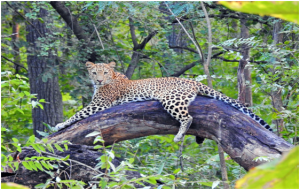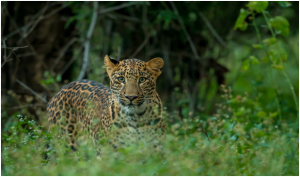
TTT NEWS NETWORK
BHOPAL | 3 MAY 2025
International Leopard Day is celebrated every year on May 3. The day was created as a lasting legacy of then Global Leopard Conference held in March 2023. It aims to raise awareness and support for the conservation of leopards and their habitats. The Day is to promote these conservation efforts and highlight the importance of leopards in maintaining ecological balance. It is estimated that there are 50,000 to 100,000 leopards in the world. Of these, India has the highest estimated population of leopards at 14,000. The total population of leopards in India is 13,874, with the highest number in Madhya Pradesh. Whose number is 3907. This is the reason why Madhya Pradesh has been given the honor of being a leopard state. The Ministry of Environment, Forest and Climate Change released a report on the population of leopards. In which information has been given about how many leopards are there in different states.
The Day, observed annually, underscores the urgent need to protect and conserve leopards worldwide. In 2025, this occasion holds special significance for India, particularly for Madhya Pradesh, often referred to as the “Leopard State” due to its substantial leopard population and rich biodiversity. The state has demonstrated a resolute commitment towards the conservation and sustainable breeding of leopards, reinforcing its role as a key player in wildlife preservation.
Madhya Pradesh is endowed with vast forested landscapes and protected areas such as Panna, Kanha, and Bandhavgarh national parks, which serve as critical habitats for leopards. Recognizing the ecological importance of these big cats, state authorities have implemented comprehensive conservation strategies. These include stringent anti-poaching measures, habitat restoration programs, and community engagement initiatives aimed at mitigating human-leopard conflicts.

Moreover, Madhya Pradesh has pioneered scientific breeding programs to ensure the genetic diversity and health of the leopard population. These efforts are complemented by research collaborations with wildlife experts and organizations that monitor leopard behavior and ecology, facilitating informed conservation policies.
The state’s dedication extends beyond conservation to fostering coexistence between humans and leopards. Awareness campaigns educate local communities about leopard behavior and the significance of preserving this apex predator, which plays a vital role in maintaining ecological balance.
On International Leopard Day 2025, Madhya Pradesh stands as a testament to effective wildlife management and environmental stewardship. The state's commitment not only contributes to the survival of leopards in India but also sets an exemplary model for leopard conservation globally.
Continued efforts in habitat protection, breeding, and community participation remain essential to securing a future where leopards thrive alongside human development.
Importance of International Leopard Day:
At the Global Leopard Conference held in the year 2023, it was decided to celebrate May 3 as International Leopard Day. Its purpose is to raise awareness and support for the conservation of leopards. As a symbol of wildlife and biodiversity, the leopard is essential for maintaining the balance of the ecosystem.
Status of leopards in the world:
Leopards were once found throughout South Asia and Africa, from Korea to South Africa. But due to hunting and habitat loss, this animal is now found only in some areas of sub-Saharan Africa as well as India, Pakistan, Malaysia and China.
States with the Highest Leopard Population in the Country:
In 2022 Madhya Pradesh: – 3907, Maharashtra: – 1985, Karnataka: – 1879, TamilNadu – : – 1070 The highest number of leopards in the country is in forests like Nagarjuna Sagar in Srisailam, Andhra Pradesh and Panna and Satpura in Madhya Pradesh.
In 2024, certain states have emerged as strongholds for leopard populations, reflecting both successful conservation efforts and suitable habitats. Among these, Madhya Pradesh leads with the highest leopard density, owing to its extensive forest cover and protected areas such as Kanha and Bandhavgarh National Parks. The state’s varied terrain and abundant prey base provide an ideal environment for sustaining large leopard populations.
Following Madhya Pradesh, Maharashtra features prominently with significant leopard numbers, particularly around the Western Ghats and forested regions like Tadoba-Andhari Tiger Reserve. The state’s mosaic of forests and human settlements has necessitated focused management strategies to mitigate human-wildlife conflicts, further enriching leopard conservation practices.
Rajasthan also reports a notable leopard presence, primarily in the Aravalli ranges and protected areas such as Sariska and Ranthambore. The state’s arid yet forested landscapes support a stable leopard population alongside other carnivores, highlighting the adaptability of leopards to diverse ecological zones.
Collectively, these states exemplify critical habitats for leopards in 2024. Ongoing conservation measures, habitat protection, and community engagement remain vital to ensuring the continued survival of leopards amidst increasing environmental challenges. The success observed in these regions serves as a model for other states aiming to preserve this iconic species.

Advertisement:





























Add Comment